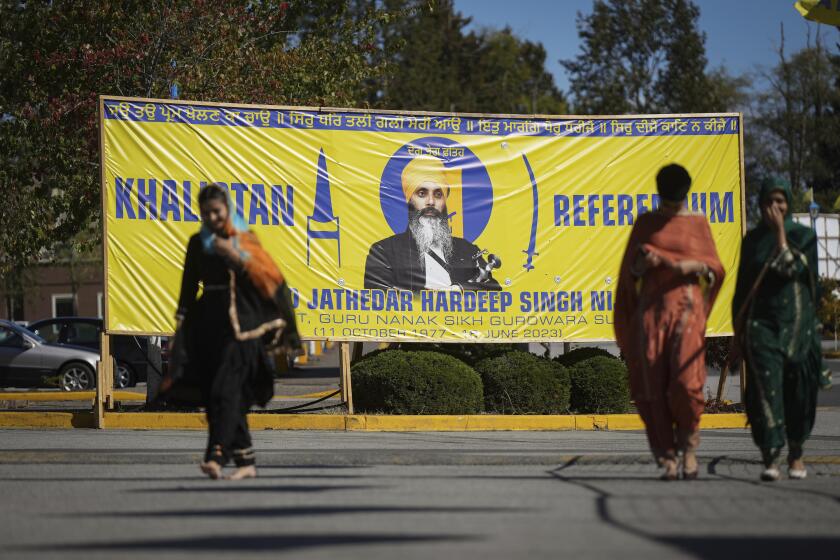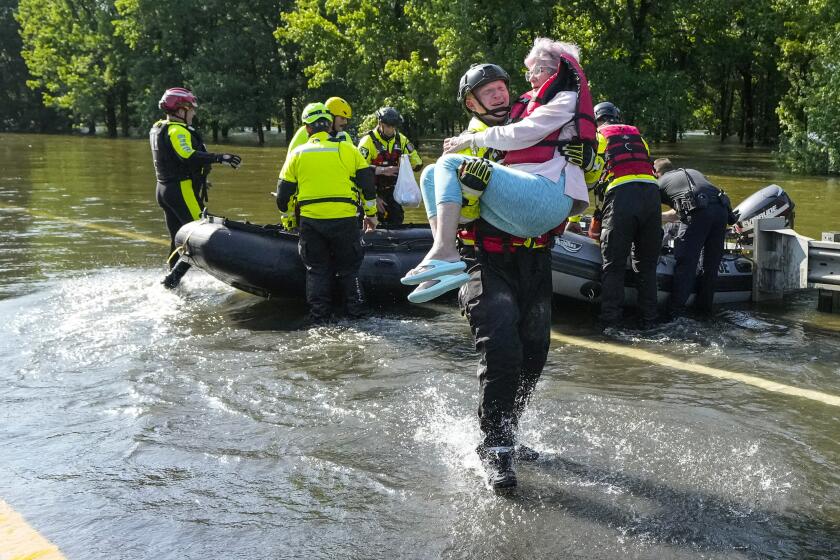Abraham J. Klausner, 92; rabbi was an advocate for Holocaust survivors
Rabbi Abraham J. Klausner, who brought attention to the plight of Holocaust survivors languishing in concentration camps at the end of World War II and created inventive ways -- including publishing a massive list of survivors -- to reunite them with their families, died Thursday at his home in Santa Fe, N.M., from complications of Parkinson’s disease. He was 92.
Klausner was featured in the 1997 Academy Award-winning documentary “The Long Way Home,” which tells the story of Holocaust survivors in the chaotic days after the liberation of Nazi concentration camps by Allied forces. In that war-ravaged landscape, still reeling with anti-Semitism, many survivors were seriously ill, had no home to which they could return and no family that could be found, so they remained in concentration camps.
A then 30-year-old Klausner was believed to be the first Jewish chaplain to enter the infamous death camp known as Dachau, northwest of Munich, Germany, after the April 1945 liberation. During his first day there, survivors peppered the U.S. Army officer with questions; they wanted to know if he knew their brother, uncle, cousin.
It was then that Klausner understood his purpose: to reunite families devastated by the Holocaust. In doing so, Klausner brought the survivors liberation of a different sort.
“Are we not, each of us, defined by our relationships ... ?” Klausner wrote in his memoir, “A Letter to My Children, From the Edge of the Holocaust.”
“Bereft of relationships, reduced to a number tattooed on the arm, they sought to discover through me a thread which would weave them back into a reality they once knew. My first battle with military authorities, though I did not see it as such, was.... to help survivors toward their identity,” he wrote.
But with so many people either displaced or dead, Klausner found reuniting families to be an overwhelming task. In July 1945, Klausner, who was based in Munich and traveled to various camps, took it upon himself to create and publish lists of Holocaust survivors in volumes he called Sharit ha-Platah, which means Surviving Remnant. Several volumes, which listed thousands of names, would eventually be printed.
Klausner also helped set up a center at a museum in Munich for survivors trying to resume their pre-war lives. Those who did not find the names of relatives on the lists wrote notes and tacked them to the walls, in the hopes that relatives might visit and find them.
“He was like a father figure to tens of thousands,” said Rabbi Marvin Hier of the Simon Wiesenthal Center in Los Angeles. “He went to all the camps. They asked him to help them.”
Inside the camps, Klausner ministered to survivors’ spiritual needs. He performed burial rites and Passover seders, and advocated for changes that would restore dignity to their lives. The way to effect change was to let the outside world see what he witnessed daily at the camps, Klausner reasoned.
In detailed reports to U.S. officials and to major Jewish organizations in America, Klausner wrote of the problems: overcrowding, dilapidated buildings, inadequate food, survivors who still wore their tattered concentration camp uniforms because they had nothing else, camps where “items such as soap, toothbrushes, linen, laundry facilities are unknown.”
It was he who introduced Earl Harrison, an emissary sent by President Harry S. Truman to investigate the camps, to the “unhappy world of an abandoned people.”
Harrison reported to Truman a blistering indictment: “As matters now stand, we appear to be treating the Jews as the Nazis treated them, except that we do not exterminate them. They are in concentration camps in large numbers under our military guard instead of SS troops.”
Klausner’s efforts brought improvements to the camps. He argued that survivors at the camps with no place to go should be sent -- even against their wills -- to what would later become the state of Israel. That stance led to his being called a militant Zionist.
“I worked in Germany until the state of Israel was proclaimed,” he said in a 1998 article in the Santa Fe New Mexican. “I figured then I was no longer needed.”
Born April 27, 1915, in Memphis, Tenn., Klausner was the son of Tillie Binstalk, an Austrian immigrant, and Joseph Klausner, a Hungarian immigrant who owned a dry goods store. Raised in Denver, Colo., Klausner graduated from the University of Denver in 1938 and from Hebrew Union College in 1941. He later earned a doctorate of divinity at Harvard University, and led temples in Boston and in Yonkers, N.Y.
In 1966, Klausner married Judith, who survives him along with their sons Jeremy, of West Orange, N.J.; Amos, of San Rafael, Calif.; and Michael of New Haven, Conn; a daughter, Robin Pressman, of Santa Rosa, Calif.; and two grandchildren, Abigail Bess and Jacob Aaron of West Orange, N.J.
In addition to his memoir, Klausner wrote four books, including “Weddings: A Complete Guide to all Religious and Interfaith Marriage Services,” published in 1986. His story is included in “The Fighting Rabbis: Jewish Military Chaplains and American History,” by Rabbi Albert Slomovitz.
“His story as an American Army officer and person of faith is a lesson in values, personal integrity and ultimate responsibility for each other,” Slomovitz said in a 1998 article in the Pensacola News Journal.
More to Read
Start your day right
Sign up for Essential California for news, features and recommendations from the L.A. Times and beyond in your inbox six days a week.
You may occasionally receive promotional content from the Los Angeles Times.






